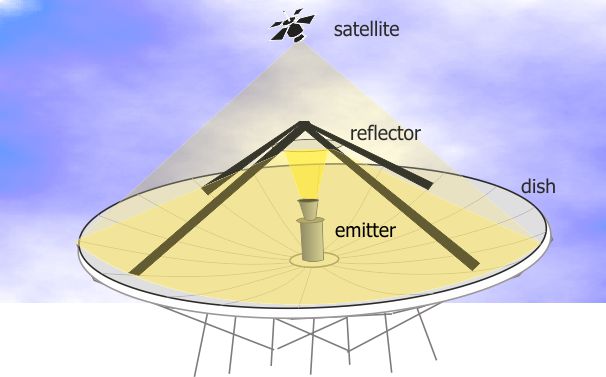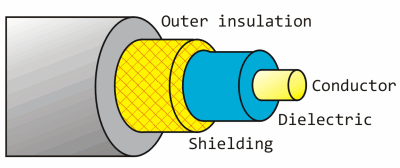Freesat reception - all about dishes
 Brian Butterworth published on UK Free TV
Brian Butterworth published on UK Free TV Satellite reception has both advantages and disadvantages compare with terrestrial (aerial) reception.
By using much higher frequencies (gigahertz, compared to terrestrial televisions megahertz) more transmission channels called transponders (the satellite equivalent of multiplexes) can be provided. For example, there are only six Freeview multiplexes, but Sky or Freesat users can access two hundred satellite transponders.
Aside from exceptional weather conditions (very heavy rain for example) digital satellite provides stable pictures and audio. Where Freeview transmitters are no more than 732 metres above sea level, the geostationary satellites used for television are 35,800,000 metres above the equator so reception is possible even where buildings, trees and hills make terrestrial reception impossible.

The downside of the transmitters being 22,300 miles up in the air is that the signals are very, very weak - so standard TV aerial is of little use. When the signals are sent to the satellites, huge dish transmitters are used to uplink the signal to the satellite. These are tens of metres from side to side, and feature an emitter that generates the signal, which is first bounced of a mirror (called a reflector) and then off the surface of the parabolic dish.

There are many satellites in the sky over the equator. Often these are in clusters over a particular position, for example there are four used for UK television are at 28.2 degrees east. There is another cluster over the 19.2 degrees east positions that are used for German television.
To receive these very weak signals from the satellite, it is necessary to use a dish for reception too. By using a reflective dish, this concentrates the signals onto a small device called a LNB. This is held in front of the dish by a metal arm.

The size of dish for reception is typically much smaller; often 60cm to 100cm in diameter, but the exact size depends upon the transmitting satellite transponder. To keep the transmission power levels down to levels that can be powered by the satellite's solar panels, each beam is focused on a particular area of the Earth's surface. If you are trying to receive the signal at the centre of this zone, a small dish is required. At the outer edges, you may need a 5 metre dish. Maps of these zones are provided by the satellite companies, and are called satellite footprints.
When the dish is installed it must be aligned carefully as the signal is very weak. The installer needs to know the inclination and the azimuth from the ground location to the satellite. If you install yourself you will find that there are markings on the dish that are used to point the dish in the correct position. It is important that the view of the satellite will not be blocked, so must take into account leaves growing on trees and potential building works.
For many people the LNB will have a single cable connected to it, however if you have Sky+ or a multi-room installation the LNB package will actually contain four receivers a quad-LNB. Unlike terrestrial television where you can split the aerial cable to feed more than one Freeview box or television set, with satelite reception you cannot. So, a Sky+ box with two receivers (so you can watch one thing and record another) has two cables connecting the box to the dish.
The cable that connects the dish to the receiver must be satellite grade cable. Whilst this looks superficially like the cable used to connect and aerial to a television, a higher grade cable is required for satellite reception.
Here is an image of a co-axial cable. This sort of cable is used to connect any type of receiving aerial to the reception equipment.

RG6, PF100 and PH100 are all types of coax cable that are suitable for the very weak signals that are received by a satellite dish. (The power is the same as you would receive from a one-bar electric heater on the moon).
The conductor in the centre passes the signals received from the dish to the set-top box. This is made from steel in RG6 cable, and from copper in the RF100 and PH100 types. This makes RG6 less suitable in the UK where rain can damage the cable.
The shielding is responsible for keeping unwanted external interference from damaging the signal. In the cheaper cable this will be a foil wrap, in better specified cables this is a braid (or mesh) of copper wires. The sheild in the RF100 covers 58% of the cable.
The non-conducting layer between the shield and the conductor is called the dielectric. This can be either a solid (RG6), foam (RF100) or air-spaced (PH100) dielectric. This makes the cables progressively more flexible (ie bendy without damage).
5:33 PM
Girvan
the nearest tree where clear line of site is available is 100m from the house - we used standard cable line but the signal drop off was too much - can you get a mini transmitter to senf sigal to the house from the dish?
| link to this comment |
paul's: mapP's Freeview map terrainP's terrain plot wavesP's frequency data P's Freeview Detailed Coverage
9:46 AM
paul : You can get an in-line satellite amplifier that is powered from your satellite receiver.
See:
http://www.vision-product…d=65
for an example.
The in-line amplifier won't work at the "house end" of the coax cable, since the signal has already dropped too much. Typically it would be used closer to the dish than mid-distance (i.e. where the signal has dropped some, but not too much). You might be able to use it close to the dish. Knowledge of your coax cable loss would help to determine the optimum position in the cable. It will need suitable protection from the weather.
| link to this comment |
2:51 PM
Hi can you give me instructions to get channel 5,on a sat dish on my caravan,im in Yorkshire.
thank you
Mac
| link to this comment |
9:55 PM
Thanks, Jim, for the answer about cable distance. Much appreciated.
| link to this comment |
9:57 PM
Ray: Hello, apologies for my ignorance, we have just moved house and found that our BT Vision will not work in this location, not only that our digital tlevisions barely work and only give us the basic 1-4 channels. There is a satellite dish on the house and cables coming into the house, so with this we have purchased a freesat box. Our problem is the box and the satellite dont appear to like each other. We have tried asll the cable all different ways. Could you possibily give us some advice on what we can do to make it work? sorry my explaination is not very good.
| link to this comment |
Michelle: BT Vision does not work with Freesat, only Freeview.
| link to this comment |
8:35 AM
Michelle: As Briantist has said, BT Vision is allied to Freeview using a normal aerial, and so if your Freeview TV's doesn't work well neither will the BT Vision box, with your reception possibilities not being able to checked on without knowledge of your post code.
However "if" you are meaning the Freesat box doesn't work with the Satellite dish, then this suggests that either the dish is out of alignment and requires re-setting, or that the dish was being used for other than Sky reception, and if so will as was previously mentioned, require re-aligning.
| link to this comment |
3:26 PM
Briantist:
Hi, I'm having problems setting up a satellite receiver. The view is fairly good but there are some normal voltage 3 phase overhead power cables adjacent to the view. Is this likely to cause a problem?
| link to this comment |
3:44 PM
Robin: Its very unlikely that they would be having any effect on what you are doing, this even applying if they were only a few feet away, albeit this being a most undesirable situation safety wise!
| link to this comment |